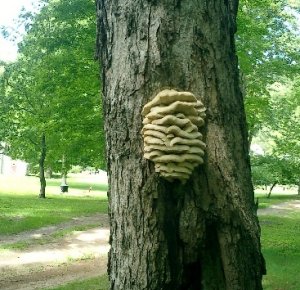
|
 October 22, 2008 October 22, 2008 
Maple Tree Fungus
|

This is the "northern tooth fungus"
I found it in Sundown on a neighbor's maple tree.
|
The picture accompanying this article was the trigger. I have seen many of these odd and interesting structures over several years. I've known what it is for almost as long. This last month I realized that maybe others don't. It's time for me to share what I do know. It's part of my job as an educator. The photo was taken a few weeks ago at a friend's property only two miles from where I live in Sundown.
Several years ago I noticed this kind of formation on a very large sugar maple at the corner of Jan's Bungalow Colony and Route 209 just outside of Ellenville. I watched it grow weekly in July over two, maybe three months. It finally reached a size about two feet high and at least a foot wide. The tree looked to be in poor health, had little foliage, and was clearly dying. Soon, the maple was cut and removed.
|
This very interesting, and, in some way, beautiful growth on the trunk was the outward manifestation of a hidden problem. The growth is the fruiting body (sometimes called a conk) of a parasitic fungus that grows by feeding on the heartwood of maple trees and other hardwood trees. Its technical name is a basidiocarp. It is the spore producing part of the fungus and is, in essence, what we call a mushroom.
Of the more than 5,000 mushrooms we see growing, a handful are considered gourmet quality eating and includes chanterelles, oysters, puff balls, shitake, crimini, enoki, morels, porcini and a few others. Of this large number there are also about 100 that are poisonous and responsible each year for deaths and/or severe illness. They are all basidiocarps. This particular one is neither poisonous nor edible. It is regarded as unpalatable, which may mean unpleasant in any of a variety of ways.
Most mushrooms we see are the fruiting bodies of a sub-surface network of mycelium, fungal threads that spread throughout the area, be it in the surface soil of a lawn or the innards of a tree. The disease is known as heartrot and it can weaken the tree over enough time that strong winds can actually snap the trunk and blow it over. Of course trees so infected pose a threat to structures as well as motor vehicles, equipment and other trees. There are a variety of trunk and limb rots that affect heartwood and sapwood of many hardwood trees and conifers.
The cream-colored shelf-like mushroom continues to grow in large overlapping clusters. Any tree so encumbered is eventually doomed. Curiously, from a great distance, the northern tooth fungus as it is known, resembles a cluster of oyster mushrooms, a very desirable, edible mushroom. The closer one gets, the greater the disappointment.
If, on the other hand, you are just searching for interesting looking fungi, you'll enjoy its unusual, fleshy, shelf-like projections and the absence of either gills or pores. Its form looks like spines hanging from each layer that are rather unique. These are referred to as teeth and the nickname, northern tooth fungus, seems appropriate. The Latin name (Climacodon septentrionalis) translates roughly to "ladder tooth found in September". The "teeth" enhance its unique spore production and dispersal. Spores are released during moist periods in late summer and fall and winds carry them to other trees with injuries and frost cracks that serve as the entry points for future host trees.
Looking at the photo I submitted, it's clear that the injury beneath the conk formation was the likely site of infection. Like most stem and trunk decay fungi, once the tree is infected, the progress will continue and cannot be reversed. Trees can live with the disease for a long time, but the final outcome is inevitable. While it may take years to manifest itself, the fungal disease works slowly and steadily decaying the heartwood of the tree to a white spongy mass. Once the fungus announces its presence, it will do so each summer/fall until it is so well established that the tree needs to be removed.
I am grateful for the privilege of occupying the same earth with
such a modest, unselfish and exceedingly useful citizen.
- J. Boone, on worms.
From
The Garden of Ed. Submitted for publication in The Towne Crier on
October 22, 2008
© 2008 Ed Mues. All Rights Reserved.

eMail:
eGarden@MountainAir.us

|

|

